
A utility knife is any type of knife used for general manual work purposes. Such knives were originally fixed-blade knives with durable cutting edges suitable for rough work such as cutting cordage, cutting/scraping hides, butchering animals, cleaning fish scales, reshaping timber, and other tasks. Craft knives are small utility knives used as precision-oriented tools for finer, more delicate tasks such as carving and papercutting.

Soap is a salt of a fatty acid used in a variety of cleansing and lubricating products. In a domestic setting, soaps are surfactants usually used for washing, bathing, and other types of housekeeping. In industrial settings, soaps are used as thickeners, components of some lubricants, and precursors to catalysts.

Sodium hydroxide, also known as lye and caustic soda, is an inorganic compound with the formula NaOH. It is a white solid ionic compound consisting of sodium cations Na+ and hydroxide anions OH−.

A washing machine is a machine designed to launder clothing. Modern-day home appliances use electric power to automatically clean clothes. The term is mostly applied to machines that use water as opposed to dry cleaning or ultrasonic cleaners. The user adds laundry detergent, which is sold in liquid, powder, or dehydrated sheet form, to the wash water.

Placer mining is the mining of stream bed (alluvial) deposits for minerals. This may be done by open-pit or by various surface excavating equipment or tunneling equipment.

A soap bubble is an extremely thin film of soap or detergent and water enclosing air that forms a hollow sphere with an iridescent surface. Soap bubbles usually last for only a few seconds before bursting, either on their own or on contact with another object. They are often used for children's enjoyment, but they are also used in artistic performances. Assembling many bubbles results in foam.

A mug is a type of cup typically used for drinking hot drinks, such as coffee, hot chocolate, or tea. Mugs usually have handles and hold a larger amount of fluid than other types of cups. Typically, a mug holds approximately 240–350 ml of liquid. A mug is a less formal style of drink container and is not usually used in formal place settings, where a teacup or coffee cup is preferred. Shaving mugs are used to assist in wet shaving.
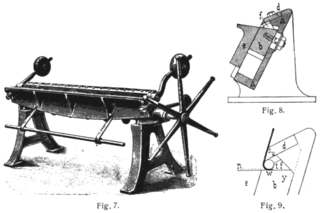
A brake is a metalworking machine that allows the bending of sheet metal. A cornice brake only allows for simple bends and creases, while a box-and-pan brake also allows one to form box and pan shapes. It is also known as a bending machine or bending brake or in Britain as a sheet metal folder or just a folder.

A cocktail shaker is a device used to mix beverages by shaking. When ice is put in the shaker, this allows for a quicker cooling of the drink before serving.
Ivory is an American flagship personal care brand created by the Procter & Gamble Company (P&G), including varieties of white and mildly scented bar soap that became famous for its claim of purity and for floating on water. Over the years, the brand has been extended to other varieties and products.

A fancy mouse is a domesticated form of the house mouse, one of many species of mice, usually kept as a type of pocket pet. Fancy mice have also been specially bred for exhibiting, with shows being held internationally. A pet mouse is inexpensive compared to larger pets, and even many other pet rodents, but mice are comparatively short-lived: typically only 2 to 3 years.
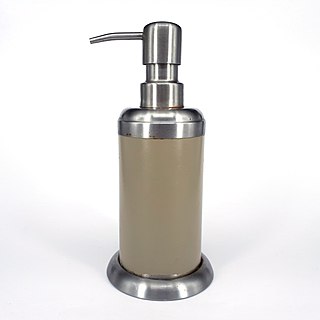
A soap dispenser is a device that, when manipulated or triggered appropriately, dispenses soap. They can be automatic or manually operated by a handle and are often found in public toilets or private bathrooms

Pears Glycerin soap is a British brand of soap first produced and sold in 1807 by Andrew Pears, at a factory just off Oxford Street in London. It was the world's first mass-market translucent soap. Under the stewardship of advertising pioneer Thomas J. Barratt, A. & F. Pears initiated a number of innovations in sales and marketing. English actress and socialite Lillie Langtry was recruited to become the poster-girl for Pears in 1882, and in doing so she became the first celebrity to endorse a commercial product.
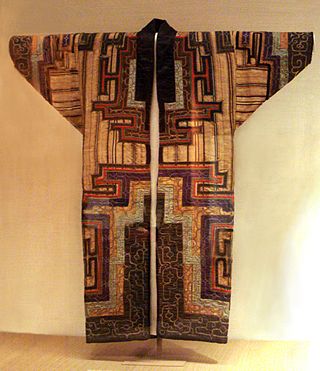
The conservation and restoration of textiles refers to the processes by which textiles are cared for and maintained to be preserved from future damage. The field falls under the category of art conservation, heritage conservation as well as library preservation, depending on the type of collection. The concept of textile preservation applies to a wide range of artifacts, including tapestries, carpets, quilts, clothing, flags and curtains, as well as objects which "contain" textiles, such as upholstered furniture, dolls, and accessories such as fans, parasols, gloves and hats or bonnets. Many of these artifacts require specialized care, often by a professional conservator.

Amish furniture is furniture manufactured by the Amish, primarily of Pennsylvania, Indiana, and Ohio. It is generally known as being made completely out of wood, usually without particle board or laminate. The styles most often used by the Amish woodworkers are generally more traditional in nature.
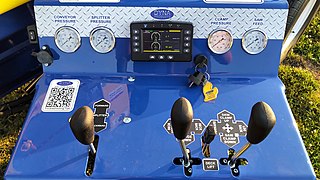
A firewood processor is a machine designed to cut and split firewood with minimal manual handling of the logs. There are typically four main parts of the machine, each dedicated to a separate function. Processing begins with a log pile – a pile of logs that have been de-limbed and cut to an appropriate length, generally 12–20 feet (3.7–6.1 m). Popular brands include DYNA, Multitek, Eastonmade, Cord King, Wood Beaver, Hakki Pilke, and Blockbuster. Many individuals use processors commercially, while some use them privately as a hobby. If someone has a small amount of wood they'd like to split but don't want to spend a lot of money, there's options to rent processors as an alternative to purchasing.

A cabinet is a case or cupboard with shelves or drawers for storing or displaying items. Some cabinets are stand alone while others are built in to a wall or are attached to it like a medicine cabinet. Cabinets are typically made of wood, coated steel, or synthetic materials. Commercial grade cabinets usually have a melamine-particleboard substrate and are covered in a high-pressure decorative laminate, commonly referred to as Wilsonart or Formica.
Palmolive is an American multinational brand of a line of products produced by Colgate-Palmolive. The Palmolive brand grew from one product, Palmolive bar soap. Made of coconut, palm and olive oils, Palmolive bar soap was introduced in 1898. Originally, the bar soap floated like Procter & Gamble's Ivory bar soap. By the turn of the 20th century, Palmolive bar soap was the world's best-selling soap.
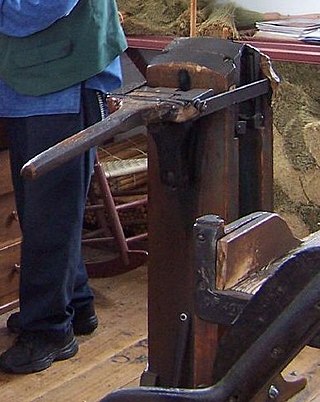
The Shaker broom vise is a specialized production vise that made the normally round broom flat to make it more efficient for cleaning purposes. The Shakers' invention revolutionized the production and form of brooms; in the process greatly expanding an industry in New England.

















